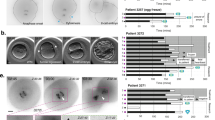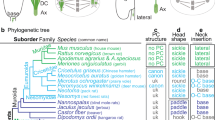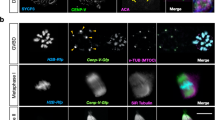Abstract
Successful fertilization in humans, achieved when parental chromosomes intermix at first mitosis, requires centrosome restoration and microtubule-mediated motility. Imaging of inseminated human oocytes reveals that the sperm introduces the centrosome. The centrosome then nucleates the new microtubule assembly to form the sperm aster — a step essential for successful fertilization. Oocytes from some infertile patients failed to complete fertilization because of defects in uniting the sperm and egg nuclei, indicating that failure to properly effect the cytoplasmic motions uniting the nuclei results in human infertility. These discoveries have important implications for infertility diagnosis and managing reproduction.
This is a preview of subscription content, access via your institution
Access options
Subscribe to this journal
Receive 12 print issues and online access
$209.00 per year
only $17.42 per issue
Buy this article
- Purchase on Springer Link
- Instant access to full article PDF
Prices may be subject to local taxes which are calculated during checkout
Similar content being viewed by others
References
Schatten, G. The centrosome and its mode of inheritance: the reduction of the centrosome during gametogenesis and its restoration during fertilization. Develop Biol 165, 299–335 (1994).
Boveri, T. Zellen-Studien: Ueber die Natur der Centrosomen. IV. (Jena, Germany, 1901).
Wilson, E.B. The Cell in Development and Heredity, (Macmillan, New York, 1925).
Mazia, D. The chromosome cycle and the centrosome cycle in the mitotic cycle. Int. rev. Cytol. 100, 49–92 (1987).
Longo, F.J. Sperm aster in rabbit zygotes: Its structure and function. J. Cell Biol. 69, 539–547 (1976).
Le Guen, P. & Crozet, N. Microtubule and centrosome distribution during sheep fertilization. Eur. J. Cell Biol. 48, 239–249 (1989).
Long, C.R. et al. Chromatin and microtubule morphology during the first cell cycle in bovine zygotes. Molec. Repro. Develop. 36, 23–32 (1993).
Yllera-Fernandez, M.D.M., Crozet, N. & Ahmed-Ali, M. Microtubule distribution during fertilization in the rabbit. Mol. Reprod. Dev. 32, 271–276 (1992).
Navara, C., First, N. & Schatten, G. Microtubule organization in the cow during fertilization, polyspermy, parthenogenesis and nuclear transfer: The role of the sperm aster. Dev. Biol 162, 29–40 (1994).
Breed, W., Simerly, C., Navara, C., Vanderberg, J. & Schatten, G. Distribution of microtubules in eggs and early embryos of marsupial, Monodelphis domestica. Dev. Biol. B, 230–240 (1994).
Schatten, G., Simerly, C. & Schatten, H. Microtubule configurations during fertilization, mitosis and early development in the mouse and the requirement for egg microtubule-mediated motility during mammalian fertilization. Proc. Natn. Acad. Sci. U.S.A. 82, 4152–4156 (1985).
Maro, B., Howlett, S.K. & Webb, M. Non-spindle microtubule organizing centers in metaphase II-arrested mouse oocytes. J. Cell Biol. 101, 1665–1672 (1985).
Schatten, H., Schatten, G., Mazia, D., Balczon, R. & Simerly, C. Behavior of centrosomes during fertilization and cell division in mouse oocytes and in sea urchin eggs. Proc. Natn. Acad. Sci. U.S.A 83, 105–109 (1986).
Sathananthan, A.H. et al. Centrioles in the beginning of human development. Proc. Natn. Acad. Sci. U.S.A 88, 4806–4810 (1991).
Wheatley, D.N. The Centriole: a Central Enigma of Cell Biology. (Elsevier, 1982).
Szöllösi, D. & Ozil, J.P. De novo formation of centrioles in parthenogenetically activated diploidized rabbit embryos. Biol. Cell. 72, 61–66 (1991).
Pickering, S.J., Johnson, M.H., Braude, P.R. & Houliston, E. Cytoskeletal organization in fresh, aged, and spontaneously activated human oocytes. Human Repro. 3, 978–989 (1988).
Schatten, H., Simerly, C., Maul, G. & Schatten, G. Microtubule assembly is required for the formation of the pronuclei, nuclear lamin acquisition, and DNA synthesis during mouse, but not sea urchin, fertilization. Gamete Res. 23, 309–322 (1989).
Palermo, G., Munné, S. & Cohen, J. The human zygote inherits its mitotic potential from the male gamete. Human Reprod. 9, 1220–1225 (1994).
Winston, N., Johnson, M., Pickering, S. & Braude, P. Parthenogenetic activation and development of fresh and aged human oocytes. Fert. Steril. 56, 904–912 (1991).
Hill, D.P., Shakes, D.C., Ward, S. & Strome, S. A sperm-supplied product essential for initiation of normal embryogenesis in Caenorhabditis elegans is encoded by the paternal-effect embryonic-lethal gene, spe-11. Dev. Biol. 136, 154–166 (1993).
Fukui, Y., Glew, A.M., Gandolfi, F. & Moor, R.M. Ram-specific effects on in vitro fertilization and cleavage of sheep oocytes matured in vitro. J. Reprod. Fert. 82, 337–340 (1988).
Rose, M.D., Biggins, S. & Satterwhite, L.L. Unravelling the tangle web, at the microtubule-organizing center. Curr. Opin. Cell Biol 5, 105–115 (1993).
Kimble, M. & Kuriyama, R. Functional component of microtuble-organizing centers. Int. Rev. Cytol. 136, 1–50 (1992).
Stearns, T., Evans, L. & Kirschner, M. g-Tubulin is a highly conserved component of the centrosome. Cell 65, 825–836 (1991).
Zheng, Y., Jung, M.K. & Oakley, B.R. g-Tubulin is present in Drosophila melanogaster and Homo sapiens and is associated with the centrosome. Cell 65, 817–823 (1991).
Palacios, M.J., Joshi, H.C., Simerly, C. & Schatten, G. g-tublin during early mouse development. J. Cell Sci. 104, 383–389 (1993).
Stearns, T. & Kirschner, M. in vitro reconstitution of centrosome assembly and function: the central role of g-tubulin. Cell 76, 623–637 (1994).
Doxsey, S.J., Stein, P., Evans, L., Calarco, P.D. & Kirschner, M. Pericentrin, a highly conserved centrosome protein involved in microtubule organization. Cell 76, 639–650 (1994).
Félix, M.-A., Antony, C., Wright, M. & Maro, B. Centrosome assembly in vitro. J. Cell Biol. 124, 19–31 (1994).
Archer, J. & Solomon, F. Deconstructing the microtubule-organizing center. Cell 76, 589–591 (1994).
Van Steerteshem, A.C. et al., High fertilization and implantation rates after intracytoplasmic sperm injection. Human Reprod. 8, 1061–1066 (1993).
Brinkley, B.R. Microtubule organizing centers. Ann. Rev. Cell Biol. 1, 147–172 (1985).
Borrero, C. et al. A program of oocyte donation and GIFT. Hum Reprod. 4, 275–279 (1989).
Simerly, C. & Schatten, G. Techniques for localization of specific molecules in oocytes and embryos. Methods in Enz. 225, 516–552 (1993).
Piperno, G. and Fuller, M. T. Monoclonal antibodies specific for an acetylated form of a-tubulin recognize the antigen in cilia and flagella from a variety of organisms. J. Cell Biol. 101, 2085–2095 (1985).
Author information
Authors and Affiliations
Rights and permissions
About this article
Cite this article
Simerly, C., Wu, GJ., Zoran, S. et al. The paternal inheritance of the centrosome, the cell's microtubule-organizing center, in humans, and the implications for infertility. Nat Med 1, 47–52 (1995). https://doi.org/10.1038/nm0195-47
Received:
Accepted:
Issue Date:
DOI: https://doi.org/10.1038/nm0195-47
This article is cited by
-
Differential Sperm Proteomics Reveals the Significance of Fatty Acid Synthase and Clusterin in Idiopathic Recurrent Pregnancy Loss
Reproductive Sciences (2023)
-
Revisiting the mystery of centrioles at the beginning of mammalian embryogenesis
Journal of Assisted Reproduction and Genetics (2023)
-
Parental genomes segregate into distinct blastomeres during multipolar zygotic divisions leading to mixoploid and chimeric blastocysts
Genome Biology (2022)
-
Two mechanisms drive pronuclear migration in mouse zygotes
Nature Communications (2021)
-
Functional Analysis of Human Pathological Semen Samples in an Oocyte Cytoplasmic Ex Vivo System
Scientific Reports (2018)



